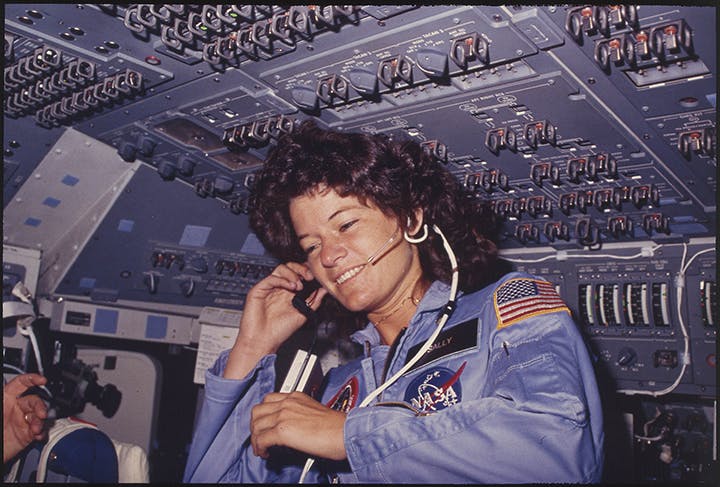IT TOOK DECADES FOR THE UNITED STATES’ NASA to send its first female astronaut into space. But long before Sally Ride’s 1983 mission, women had already played a vital role in humanity’s reach for the stars. Many of those previously unsung heroes have finally begun to gain recognition in books and films like Hidden Figures, the story of the all-African-American Langley West Area Computing Unit. In 2007, the “Mercury 13,” America’s first female astronaut candidates, were awarded honorary doctorates from the University of Wisconsin–Oshkosh—a long-overdue acknowledgment of their pioneering work. More recently, women comprised half of NASA’s 2013 astronaut class. Over 55 women have been to space, and hundreds if not thousands of others have helped them achieve that goal.
Women in STEM (science, technology, engineering, and mathematics) can be traced back to ancient history. Women were involved in astronomy and mathematics as far back as Enheduanna, a Sumerian priestess and poet who lived sometime around 2300 BCE and whose ceremonial role involved making accurate calculations and predictions regarding the visible heavens. Hypatia of Alexandria, who lived in the 4th century, is credited with the designs of an astrolabe, hydrometer, and a water distillation apparatus. Many women were looking to the stars striving for scientific knowledge, but it wouldn’t be until the beginning of the Space Race, around 1955, when things really picked up.
The Langley Memorial Aeronautical Laboratory in Virginia was part of NASA’s predecessor organization, the National Advisory Committee for Aeronautics (NACA). In 1935, the lab created its first pool of female “computers,” as they were called then. Mostly classified as “subprofessionals,” they were paid less than entry-level men. As it was, many men were aghast that women were being recruited for math work in the first place, since they felt that the delicate female mind could not possibly process mathematics as well as men. It wasn’t until 1941, when President Franklin D. Roosevelt signed two Executive Orders—8802, which desegregated the defense industry, and 9346, which formed the Fair Employment Practices Committee—that African-American women began pouring into defense positions.
Those executive orders lead directly into the story told in Hidden Figures of the 1943 Langley West Area Computing Unit, which was staffed completely by black women. Among them were Christine Darden, the first African American woman promoted to the Senior Executive Service, the highest rank in the U.S. Civil Service, and hired by NASA in 1967; Mary Jackson, NASA’s first African American female engineer, hired in 1951; Katherine Johnson, who helped calculate trajectories for America’s first manned space missions as well as the Apollo 11 moon landing, hired in 1953; and Dorothy Vaughan, NACA’s first African American supervisor and one of its first women supervisors, who was hired in 1943.
THE 1940S WAS ALSO WHEN THE JET PROPULSION Laboratory (JPL) was founded in order to research rocket technology. Several notable women were involved in the initial work, including Barby Canright, who was responsible for the thrust-to-weight ratio calculations for critical jet-assisted takeoff (JATO) units. Barbara Lewis Paulson, who went on to a 48-year career with the JPL, worked on Explorer-1 (America’s first satellite), the Mariner series, Galileo, and Magellan. Helen Ling also had a long career at JPL as a software engineer; she was so good that the designer of the Voyager mission only wanted her to work on the software for the project. Ling also worked on the Mars Observer and Magellan, among other missions.
The next major step forward for women in new technology (again, long ignored by the government) happened in 1946. A team of six—Frances Bilas Spence, Jean Jennings Bartik, Ruth Teitelbaum, Kay McNulty, Betty Holberton, and Marlyn Wescoff Meltzer—taught themselves to code, and then programmed the ENIAC, which was developed at the University of Pennsylvania. The room-sized computer was used to calculate ballistic trajectories, and could do so in seconds. The all-female team was chosen because World War II had sapped most male engineering talent at the time. Despite indifferent training and guidance from often-dubious male colleagues, these women proved they were more than capable of mastering ENIAC.

Then, while the U.S. and Russia faced off in the Cold War, they were also competing in the Space Race. Not only were women working in the labs and research facilities, but they were also going into space themselves … or rather, they were training to do so. The Women in Space Program was the brainchild of Air Force Brigadier General Donald Flickinger and William Randolph Lovelace II, an Army physician with an interest in high-altitude flight. NASA had turned the project down, but Lovelace and Flickinger hoped the Air Force would be interested.
While in Russia, the two men found out the Russians were considering women for cosmonaut training, and they thought the U.S. should do the same for its space programs. Jerrie Cobb, a 28-year-old woman with 16 years of flight experience, and aeronautics pioneer Ruth Nichols, who was 58 at the time, went through initial tests that Lovelace had created for the Mercury program. Lovelace invited 25 women for the tests, and Cobb and a dozen other women passed—the Mercury 13.
Unfortunately, none of them were ever allowed to ride the rockets. Russia won that race, sending Valentina Tereshkova up as the first woman in space in 1963. Tereshkova spent five days in space for the Vostok 6 mission, made 48 orbits, and surpassed the collective space flight time of all U.S. astronauts to date. Though there were other female cosmonauts, Tereshkova was the only one to go up in those days. She continued working with the space program in Star City, Russia’s secret space training center outside of Moscow, until 1997.
Nineteen years passed before another woman would travel to space. Svetlana Yevgenyevna Savitskaya was a research cosmonaut on the Soyuz T-7 in 1982 on her way to the Salyut 7 space station. And since the Soviet Union knew of U.S. plans to put its first woman into space, which occurred with Sally Ride’s 1983 flight, it sent Savitskaya to space again in 1984, making her the first woman to make two trips to space, and the first woman to conduct “extravehicular activity” (EVA)—walk in space.
WOMEN HAD BEEN A PART OF THE AMERICAN astronaut program since 1978, when six women were chosen out of 21 female finalists (of 208 total), Sally Ride among them. Ride made it to space as the first American woman aboard the space shuttle Challenger on June 18, 1983. Ride was also the youngest person to reach space. As part of her project aboard the shuttle, she helped launch two satellites using the remote-controlled Canadarm, or Shuttle Remote Manipulator System (SRMS).
Next came Elena V. Kondakova, the first female astronaut on a long-duration mission. She was a flight engineer on the Soyuz TM-17 and assisted in docking with the Mir space station. Kondakova spent 169 consecutive days in space in 1994–95, then returned in 1997 on the STS-84 mission aboard the space shuttle Atlantis. In 1999 she went into politics and began serving in Russia’s parliament.
Women became far more common in space as of the 21st century, with over a dozen more flying on missions for various countries. Almost every one represented some new sort of “first,” as when Mae Jemison became in 1992 the first African American female astronaut in space.
It’s important to remember that space flight is about much more than the rockets and people inside them. Vast resources and personnel in a variety of disciplines are required to make a space program function, and there have been and are many women in critical non-flight roles throughout the space industry.
“Pickering’s Women,” sometimes waggishly referred to as “Pickering’s Harem,” worked at the Harvard College Observatory in the early 20th century for astronomer Edward C. Pickering. They were tasked with finishing the Henry Draper Catalogue, a project begun by Mary Anna Palmer Draper to classify all the stars her husband, Henry, had imaged in his amateur astrography. A member of Pickering’s group, Annie Jump Cannon, shares the credit with Pickering for creating the Harvard Classification Scheme, which classifies stars with a letter (O, B, A, F, G, K, M) or a letter-number-letter based on their position in the star’s life cycle.
Other members of the Pickering team included Williamina Fleming, who created a method of star classification by hydrogen content and who worked on discovering the origins of white dwarf stars. Fleming was the first American woman to be admitted as an honorary member of the Royal Astronomical Society. Cecilia Helena Payne-Gaposchkin went on to be Harvard’s first female professor of astronomy, as well as its first female department chair.
And Henrietta Swan Leavitt developed a system of classifications of Cepheid variable stars, whose luminosity pulsates in a well-defined pattern. This discovery, which is usable for stars up to 10 million light-years away, allowed later generations to know how far a Cepheid variable was from Earth by determining its pulsation period. This was to form the basis of Edwin Hubble’s calculations of the distance to those stars and in turn allow him to estimate the size of the universe.
That’s just the beginning of what women have contributed to space sciences. Vera Rubin was an astronomer who took on the study of some of the largest structures in the universe. In 1963, she was able to measure the rotation of a galaxy with a telescope. She went on to perform important foundational work on dark matter with her longtime collaborator, Kent Ford. The two scientists also hypothesized about the large-scale streaming of the universe in what is now known as the Rubin-Ford Effect. Rubin was the first woman to be an observer at the Palomar Observatory, won the Gold Medal from the Royal Astronomical Society (the first woman since 1828), and was awarded the President’s National Medal of Science by Bill Clinton in 1993.
More recently, much of the exciting astronomical news has been the discovery of extrasolar planets, or exoplanets, planets outside of our local solar system. Astronomer and planetary scientist Sara Seager has discovered over 700 exoplanets in her time working with the Kepler Space Telescope. She has been called an “astronomical Indiana Jones” in a NASA publication. Seager has not only discovered the planets but also done considerable analysis of those planets and their atmospheres. She coined the term “gas dwarf,” which describes a planet larger than Earth but smaller than Uranus or Neptune, with an atmosphere mostly made of hydrogen and helium. She has also created a variation on the Drake Equation, which estimates the probability of the existence of intelligent alien life based on detectable radio waves; Seager’s version instead looks for the atmospheric gases created by life.
Space science means space technology, and here also women have made their influence felt. Just a few examples include Minal Sampath, an engineer who oversaw the Indian Space Research Organization’s Mars Orbiter mission and the unprecedented launch of 104 satellites in a single project; entrepreneur and electrical engineer Naomi Kurahara, who is developing a network of ground stations for satellite communications as CEO and co-founder of cloud software startup Infostellar; Abimbola Alale, head of a Nigerian communications satellite company; and Maggie Aderin-Pocock, a space educator and scientist whose work for the UK includes aircraft missile detection.
Without women space scientists, we might not have discovered radio pulsars, found the connection between Saturn’s rings and magnetic fields, built the Hubble Space Telescope, or even formed NASA, which has in recent years made a point of recognizing contributions of women, creating special sections on its website for women in STEM and the Women in Space program. The number of women who have already followed in the footsteps of Enheduanna and Hypatia shows that to reach the stars, live among them, and perhaps find alien life, we’ll need the best work from every gender.












